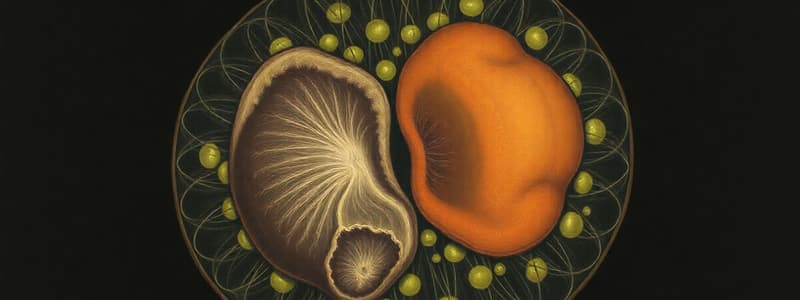Podcast
Questions and Answers
What are the phases of the cell cycle?
What are the phases of the cell cycle?
G1, S, G2, M
What types of reproduction produce new cells?
What types of reproduction produce new cells?
- Sexual reproduction
- Both A and B (correct)
- Neither A nor B
- Asexual reproduction
What happens during the G1 phase of the cell cycle?
What happens during the G1 phase of the cell cycle?
Cell grows and acquires size for division.
What is the main event during the S phase?
What is the main event during the S phase?
What is the purpose of the G2 checkpoint?
What is the purpose of the G2 checkpoint?
What are the four phases of mitosis?
What are the four phases of mitosis?
Match the following types of cell death:
Match the following types of cell death:
What happens when a cell loses control of its cell cycle?
What happens when a cell loses control of its cell cycle?
What role does the p53 gene play in the cell cycle?
What role does the p53 gene play in the cell cycle?
What is the difference between necrosis and apoptosis?
What is the difference between necrosis and apoptosis?
What are two processes involved in tissue repair and growth?
What are two processes involved in tissue repair and growth?
Flashcards are hidden until you start studying
Study Notes
Introduction
- New cells are needed for growth, replacement of damaged or lost cells, and reproduction.
- There are two types of reproduction: asexual and sexual.
Cell Division
- Asexual Reproduction:
- One cell divides into two identical cells.
- Examples: mitosis (in eukaryotes) and binary fission (in prokaryotes).
- Sexual Reproduction:
- Two cells (an egg and a sperm) join to produce a new cell (zygote) that is not identical to the parent cells.
- Example: meiosis.
- Prokaryotic Cell Divison (Binary Fission):
- Prokaryotes have a single circular DNA molecule.
- The DNA molecule replicates and each copy is attached to the cell membrane.
- The cell pulls apart, separating the replicated DNA molecule and the original DNA molecule.
- Two identical daughter cells are formed.
- Eukaryotic Cell Division:
- Eukaryotes divide their cells when there is a need for new cells due to growth, damage, or other reasons.
- Cell division starts when the cell reaches an appropriate size with enough protein and energy.
- The Cell Cycle describes the stages of a cell's life from its division to the next division.
Cell Cycle
- The cell cycle is divided into three phases:
- Interphase (G1, S, G2):
- G1: Cell grows to an appropriate size, increases protein supply, and increases organelles.
- S: DNA replicates.
- G2: The cell grows further and synthesizes proteins and organelles needed for division.
- M Phase (Mitosis): Division of the nucleus.
- C Phase (Cytokinesis): Division of the cytoplasm.
- Interphase (G1, S, G2):
- Mitosis:
- Occurs only in eukaryotes.
- Some cells (nerve, brain) do not undergo mitosis.
- Four phases of mitosis: Prophase, Metaphase, Anaphase, Telophase.
- Prophase:
- Chromatin condenses into chromosomes.
- Nucleolus and nuclear membrane disappear.
- Mitotic spindle forms from centrioles.
- Metaphase:
- Chromosomes attach to spindle fibers and line up at the cell equator.
- Anaphase:
- Spindle fibers pull sister chromatids apart, separating the chromosomes.
- Telophase:
- Chromosomes decondense into chromatin.
- Nuclear envelope reforms.
- Nucleolus becomes visible.
- Spindle breaks apart.
- Cytokinesis:
- The cytoplasm is divided into two daughter cells through a cleavage furrow in animal cells.
- The cleavage furrow is formed by actin and myosin contractile rings.
Regulation of the Cell Cycle
- The cell cycle is regulated to prevent uncontrolled cell division.
- Cyclins and Cyclin-Dependent Kinases (CDKs):
- Regulatory molecules involved in cell cycle control.
- Cyclins (regulatory subunits) and CDKs (catalytic subunits) form a complex that phosphorylates and activates or deactivates target proteins.
- Checkpoints:
- Monitor and regulate the progress of the cell cycle.
- Prevent cell cycle progression at specific points, ensuring proper processes and DNA repair.
- G1 Check Point: Ensures everything is ready for DNA replication.
- G2 Check Point: Ensures the cell is ready for mitosis.
- Metaphase Checkpoint: Ensures the cell is ready to complete cell division.
Uncontrolled Cell Division and Tumor Formation
- Loss of cell cycle control can lead to uncontrolled cell division and tumor formation.
- A damaged p53 gene can lead to cancer cells that do not respond to cell cycle control signals.
- Cancer cells with defective p53 continue dividing uncontrollably, forming tumors.
Cancer
- Cancer is a failure of cell division control causing uncontrolled tissue growth.
- This uncontrolled growth occurs due to the loss of checkpoint stops.
- The p53 gene plays a key role in the G1/S checkpoint, halting cell division if damaged DNA is detected, but cancer cells often shut down p53 activity.
Cell Death
- Necrosis (Unregulated Cell Death):
- Cell death in an organ or tissue due to disease, injury, blood supply failure.
- Apoptosis (Regulated Cell Death):
- An energy-dependent programmed cell death that eliminates unwanted cells.
Apoptosis in Physiological Situations
-
Apoptosis helps to eliminate excess cells during embryonic development, tissue remodeling, and to remove cells that are no longer needed.
-
Examples:
- Removing excess cells between fingers and toes during embryonic development.
- Eliminating cells during the metamorphosis of a tadpole into a frog.
- Removing cells that are no longer needed in the mammary gland after lactation.
- Removing cells in the prostate gland regulated by testosterone.
Apoptosis in Disease
- Too Much Apoptosis:
- Can lead to tissue atrophy, neurodegeneration, and thin skin.
- Too Little Apoptosis:
- Can lead to hyperplasia, atherosclerosis, and cancer.
Studying That Suits You
Use AI to generate personalized quizzes and flashcards to suit your learning preferences.




